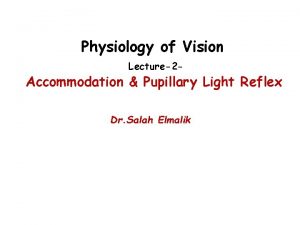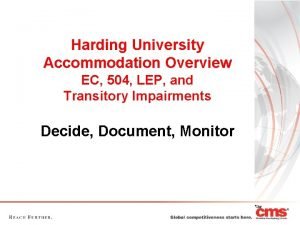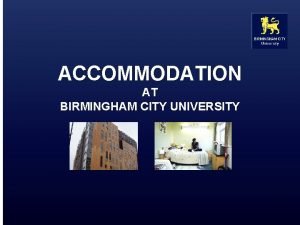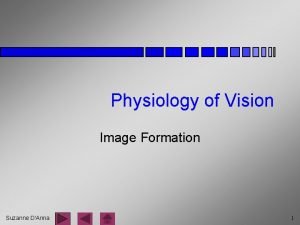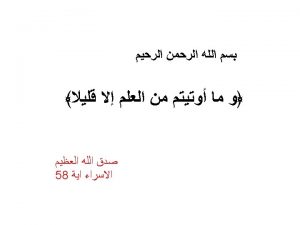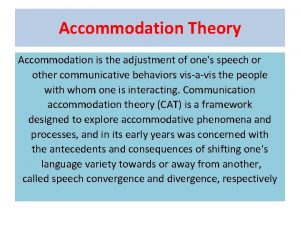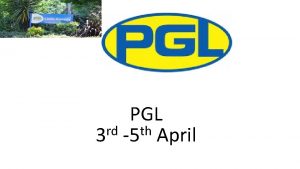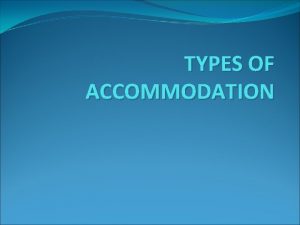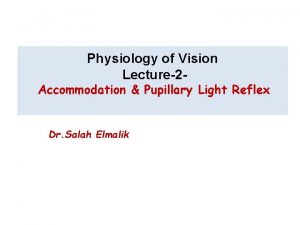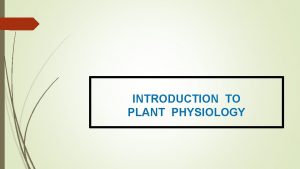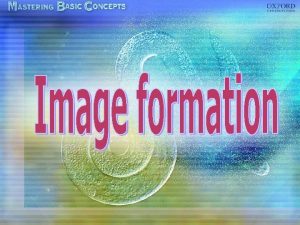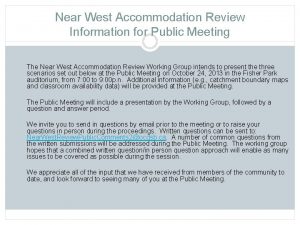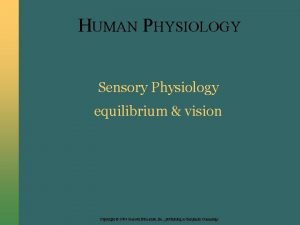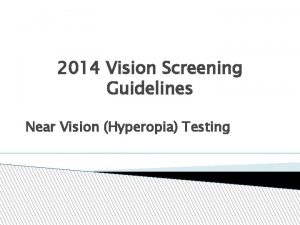PHYSIOLOGY OF VISION ACCOMMODATION FOR NEAR VISION l





















- Slides: 21

PHYSIOLOGY OF VISION







ACCOMMODATION FOR NEAR VISION l 1 -An object at infinity (i. e. more than 6 m from the eye)emits parallel rays which are refracted by the cornea and lens to form a clear focused image on the retina without any effort of accommodation. under such condition the focus will be 24 mm behind the anterior surface of the cornea(on the retina)


ACCOMMODATION FOR NEAR VISION l 2 -An object at a distance of 6 m infront of the eye will have its focus still on the retina. Again under such condition the eye needs no accommodation. l 3 -An object at distance less than 6 m infront of the eye has its focus behind the retina. In this case accommodation for near vision must take plase to have a clear focused image on the retina.

ACCOMMODATION FOR NEAR VISION l So accommodation is the ability of the crystalline lens to increase its curvature and hence its refractive power. The refractive power of the crystalline lens of the eye can be voluntarily increased from 15 diopters to approximately 29 diopters in young children with a total accommodation of 14 diopters.

ACCOMMODATION FOR NEAR VISION l To do this, the shape of lens is changed from that of a moderately convex lens to that of a very convex lens.

PHYSIOLOGY OF VISION Nervous pathway of the accommodation or near reflex -The stimulus is the blurred retinal image -Retina → optic nerve → optic chiasma -The impulses relay in the lateral geniculate body → occipital cortex (area 17 &18, 19) then the fibers follow

PHYSIOLOGY OF VISION l 1 -Some fibers pass to area 8(frontal eye field area) → corona radiate, internal capsule and brain stem to somatic part of the 3 ed nerve nucleus which supplies the medial rectus muscle of both sides resulting in convergence of both eyes.

PHYSIOLOGY OF VISION l 2 - The other fibers pass→ Edingerwestphal nucleus of the 3 ed cranial nerve relay in the ciliary ganglion the postganglionic fibers to the: l -Sphincter pupillae muscle→ miosis. l -Ciliary muscle → accommodation for near vision.

PHYSIOLOGY OF VISION l THE PUPILLARY LIGHT REFLEX l Nervous pathway of the light reflex: Stimulation of the visual receptors(rods &cons)in the retina→optic nerve→optic chiasma→optic tract(i. e. fibers coming from the nasal part of the retina cross in the chiasma to reach the optic tract of the opposite side, temporal fibers go →optic tract of the same side).

THE PUPILLARY LIGHT REFLEX l The light reflexes fibers leave the optic tract before it reaches the lateral geniculate body to relay in the pretectal nuclei of the same side. This is the center for the reflex.

THE PUPILLARY LIGHT REFLEX l Then impulses pass through the tectonuclear tract to Edenger-westiphal nuclei of the oculomotor nerve on both sides (this is autonomic nucleus of the 3 ed cranial nerve). Preganglionic fibers pass through both oculomotor nerves to relay in the ciliary ganglia. Post-ganglionic fibers enter the eye through short ciliary nerves to end in the sphincter pupillae muscles of both eyes causing constriction of both pupils.



 Accommodation eye reflex
Accommodation eye reflex Near reflex pathway
Near reflex pathway Accommodation near harding university
Accommodation near harding university Jennens court bcu
Jennens court bcu Near foot near shoulder tackling
Near foot near shoulder tackling Physiology of vision
Physiology of vision Physiology of vision
Physiology of vision Electromagnetic spectrum
Electromagnetic spectrum Tallinjen
Tallinjen För och nackdelar med firo
För och nackdelar med firo Indikation för kejsarsnitt på moderns önskan
Indikation för kejsarsnitt på moderns önskan Toppslätskivling effekt
Toppslätskivling effekt Borra hål för knoppar
Borra hål för knoppar Redogör för vad psykologi är
Redogör för vad psykologi är Bris för vuxna
Bris för vuxna En lathund för arbete med kontinuitetshantering
En lathund för arbete med kontinuitetshantering Bra mat för unga idrottare
Bra mat för unga idrottare Gumman cirkel sång
Gumman cirkel sång Offentlig förvaltning
Offentlig förvaltning Ledarskapsteorier
Ledarskapsteorier Datorkunskap för nybörjare
Datorkunskap för nybörjare Mantel som bars av kvinnor i antikens rom
Mantel som bars av kvinnor i antikens rom
